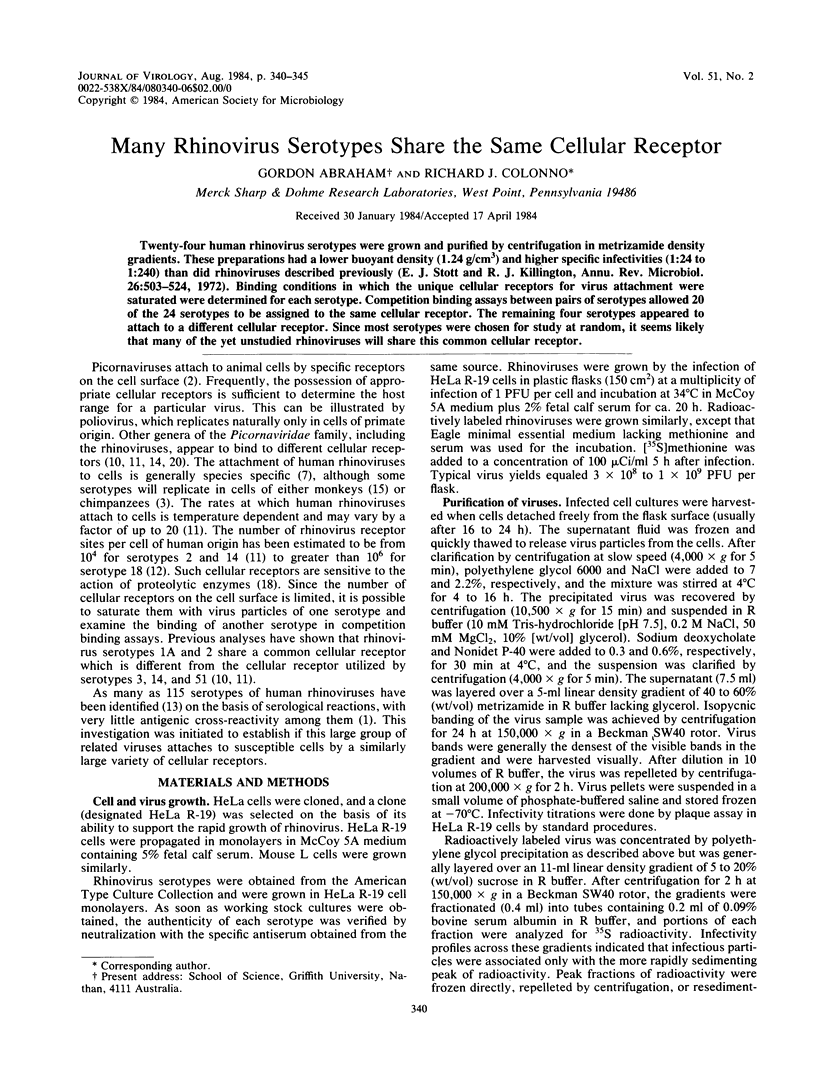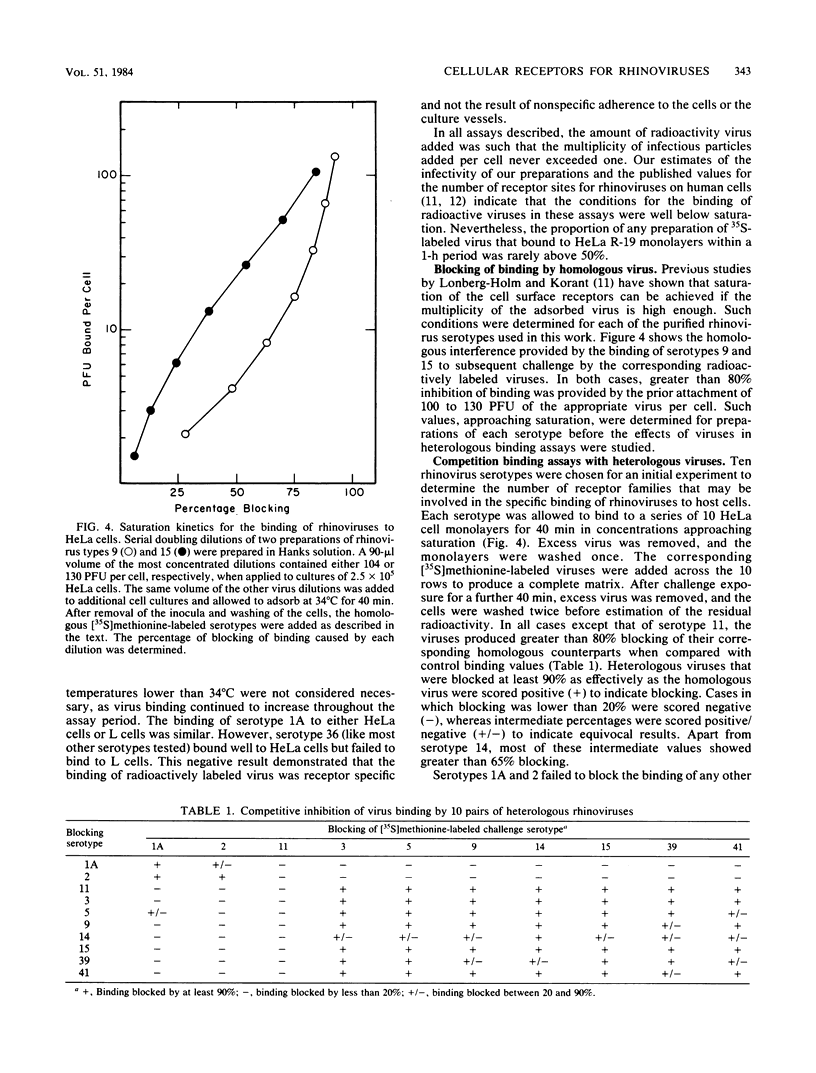Abstract
Twenty-four human rhinovirus serotypes were grown and purified by centrifugation in metrizamide density gradients. These preparations had a lower buoyant density (1.24 g/cm3) and higher specific infectivities (1:24 to 1:240) than did rhinoviruses described previously (E. J. Stott and R. J. Killington, Annu. Rev. Microbiol. 26:503-524, 1972). Binding conditions in which the unique cellular receptors for virus attachment were saturated were determined for each serotype. Competition binding assays between pairs of serotypes allowed 20 of the 24 serotypes to be assigned to the same cellular receptor. The remaining four serotypes appeared to attach to a different cellular receptor. Since most serotypes were chosen for study at random, it seems likely that many of the yet unstudied rhinoviruses will share this common cellular receptor.
Full text
PDF





Images in this article
Selected References
These references are in PubMed. This may not be the complete list of references from this article.
- Cooney M. K., Fox J. P., Kenny G. E. Antigenic groupings of 90 rhinovirus serotypes. Infect Immun. 1982 Aug;37(2):642–647. doi: 10.1128/iai.37.2.642-647.1982. [DOI] [PMC free article] [PubMed] [Google Scholar]
- Dick E. C. Experimental infections of chimpanzees with human rhinovirus types 14 and 43. Proc Soc Exp Biol Med. 1968 Apr;127(4):1079–1081. doi: 10.3181/00379727-127-32875. [DOI] [PubMed] [Google Scholar]
- Gauntt C. J. Fragmentation of RNA in virus particles of rhinovirus type 14. J Virol. 1974 Mar;13(3):762–764. doi: 10.1128/jvi.13.3.762-764.1974. [DOI] [PMC free article] [PubMed] [Google Scholar]
- Gauntt C. J., Griffith M. M., Sauck J. R., Upson R. H., Carlson E. C. Properties and origins of infectious rhinovirus type 14 particles of different buoyant densities. J Virol. 1975 Nov;16(5):1265–1272. doi: 10.1128/jvi.16.5.1265-1272.1975. [DOI] [PMC free article] [PubMed] [Google Scholar]
- Gerin J. L., Richter W. R., Fenters J. D., Holper J. C. Use of zonal ultracentrifuge systems for biophysical studies of rhinoviruses. J Virol. 1968 Sep;2(9):937–943. doi: 10.1128/jvi.2.9.937-943.1968. [DOI] [PMC free article] [PubMed] [Google Scholar]
- Haff R. F., Wohlsen B., Force E. E., Stewart R. C. Growth characteristics of two rhinovirus strains in WI-26 and monkey kidney cells. J Bacteriol. 1966 Jun;91(6):2339–2342. doi: 10.1128/jb.91.6.2339-2342.1966. [DOI] [PMC free article] [PubMed] [Google Scholar]
- Korant B. D., Lonberg-Holm K., Noble J., Stasny J. T. Naturally occurring and artificially produced components of three rhinoviruses. Virology. 1972 Apr;48(1):71–86. doi: 10.1016/0042-6822(72)90115-8. [DOI] [PubMed] [Google Scholar]
- Laemmli U. K. Cleavage of structural proteins during the assembly of the head of bacteriophage T4. Nature. 1970 Aug 15;227(5259):680–685. doi: 10.1038/227680a0. [DOI] [PubMed] [Google Scholar]
- Lonberg-Holm K., Crowell R. L., Philipson L. Unrelated animal viruses share receptors. Nature. 1976 Feb 26;259(5545):679–681. doi: 10.1038/259679a0. [DOI] [PubMed] [Google Scholar]
- Lonberg-Holm K., Korant B. D. Early interaction of rhinoviruses with host cells. J Virol. 1972 Jan;9(1):29–40. doi: 10.1128/jvi.9.1.29-40.1972. [DOI] [PMC free article] [PubMed] [Google Scholar]
- Medrano L., Green H. Picornavirus receptors and picornavirus multiplication in human-mouse hybrid cell lines. Virology. 1973 Aug;54(2):515–524. doi: 10.1016/0042-6822(73)90161-x. [DOI] [PubMed] [Google Scholar]
- Melnick J. L. Taxonomy of viruses, 1980. Prog Med Virol. 1980;26:214–232. [PubMed] [Google Scholar]
- PHILIPSON L., BENGTSSON S., BRISHAMMAR S., SVENNERHOLM L., ZETTERQVIST O. PURIFICATION AND CHEMICAL ANALYSIS OF THE ERYTHROCYTE RECEPTOR FOR HEMAGGLUTINATING ENTEROVIRUSES. Virology. 1964 Apr;22:580–590. doi: 10.1016/0042-6822(64)90080-7. [DOI] [PubMed] [Google Scholar]
- Pinto C. A., Haff R. F. Experimental infection of gibbons with rhinovirus. Nature. 1969 Dec 27;224(5226):1310–1311. doi: 10.1038/2241310a0. [DOI] [PubMed] [Google Scholar]
- Rowlands D. J., Sangar D. V., Brown F. Buoyant density of picornaviruses in caesium salts. J Gen Virol. 1971 Oct;13(1):141–152. doi: 10.1099/0022-1317-13-1-141. [DOI] [PubMed] [Google Scholar]
- Stott E. J., Heath G. F. Factors affecting the growth of Rhinovirus 2 in suspension cultures of L132 cells. J Gen Virol. 1970 Jan;6(1):15–24. doi: 10.1099/0022-1317-6-1-15. [DOI] [PubMed] [Google Scholar]
- Stott E. J., Killington R. A. Rhinoviruses. Annu Rev Microbiol. 1972;26:503–524. doi: 10.1146/annurev.mi.26.100172.002443. [DOI] [PubMed] [Google Scholar]
- ZAJAC I., CROWELL R. L. LOCATION AND REGENERATION OF ENTERIOVIRUS RECEPTORS OF HELA CELLS. J Bacteriol. 1965 Apr;89:1097–1100. doi: 10.1128/jb.89.4.1097-1100.1965. [DOI] [PMC free article] [PubMed] [Google Scholar]



